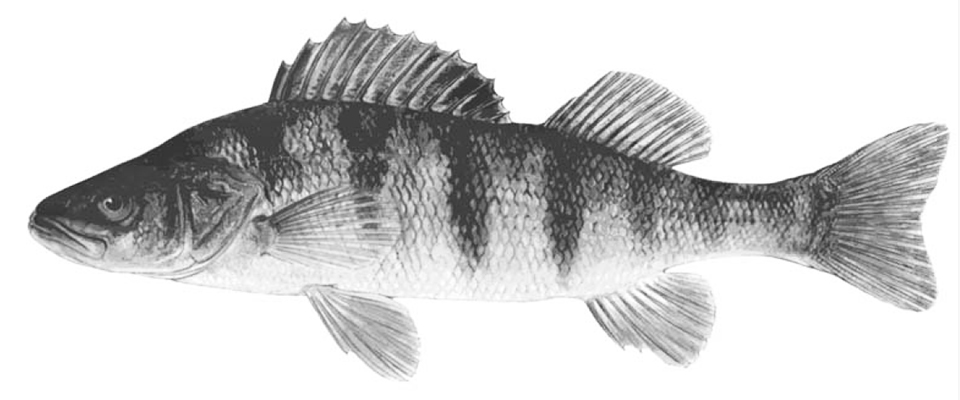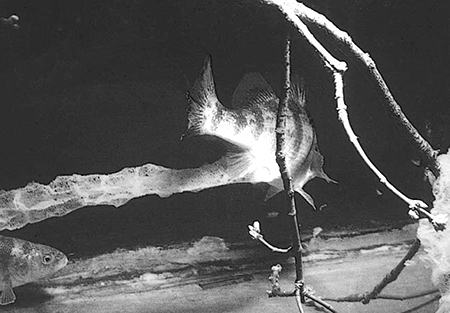Yellow perch has many positive attributes for cultivation at scale

While other species progressed to commercialization in the United States faster than yellow perch (Perca flavescens), the move to bring the fish to commercial status is well founded. The characteristics of yellow perch compare well with those of more commonly cultured species.
Market
During the 1950s and 1960s, yellow perch harvests from the North American Great Lakes exceeded 15 million kg per year, and markets readily absorbed those supplies. Then wild harvests declined to the range of 5 million to 8 million kg per year or less during the 1980s and 1990s. Most fisheries biologists predict the peak wild harvests will never return.
Today, the aquaculture industry is adding to the supply, but contributes less than 90 metric tons (MT) annually. Aquaculture products may have a marketing advantage over wild-caught products because of their superior freshness, and concerns over microcontaminants in wild-caught products from the Great Lakes and elsewhere.
Compared to other species, yellow perch:
Grow rapidly to a large size.
The fish grow more slowly than other cultured species. However, the market size (115 to 150 g, whole fish) is consistently smaller than for most other cultured food fish, so the required growout times tend to be shorter than they would be if the market demanded larger fish. Good management practices play important roles in maximizing the growth potential of yellow perch and most other fishes.
Reach market size before reaching sexual maturity.
Yellow perch rely on environmental cues – specifically, decreasing photoperiod and temperature – to trigger gametogenesis. In the absence of these cues, such as in environmentally controlled growout systems, gametogenesis and a subsequent attenuation in somatic growth are not issues, and maximum somatic growth can continue unabated. In time, some believe that genetic selection and manipulation will produce yellow perch that display postponed sexual maturation.
Readily accept a formulated diet.
Yellow perch are no less likely to accept artificial feeds than other cultured species after reaching a size of 50 mm TL. First feeding (as discussed below) can be problematic, but the fish feed vigorously on formulated diets and perform well, even on diets not specifically designed for yellow perch.
Feed fairly low on the food chain.
The fish feed low on the food chain, with a diet in the wild that consists of zooplankton, insects, and other benthic organisms, with only occasional small fishes. The optimal dietary crude protein requirement for yellow perch is in the range of 21 to 27 percent, suggesting that relatively lowcost diets will produce acceptable production results.
Not cannibalistic.
With respect to cannibalism, yellow perch behavior is relatively benign, both on an absolute basis and certainly relative to many other cultured species. Professionals cite good management as a key factor in minimizing cannibalism, regardless of species.
Fairly disease resistant.
The fish are by no means “bulletproof” with regard to disease. However, they are no more susceptible to disease than other species listed in Table 1. Production system management plays a very important role in the nature, frequency, and severity of disease outbreaks, as it does with all cultured species.
Handle well.
The consensus of experts is that the tolerance of yellow perch to handling is no less than, or comparable to, most other species listed in Table 1, with the possible exception of tilapia.
Produce offspring large enough to accept pelleted feeds at first feeding.
Developing acceptable first feeds for yellow perch has been challenging and a subject of ongoing research. However, evidence suggests real progress in habituating earlyfingerling yellow perch (less than 15 mm TL) to artificial diets.
Easily cultured under high rearing densities.
Research has shown that this species thrives under rearing densities and flow indexes that compare favorably to those tolerated by rainbow trout and salmon, perhaps because in nature they are a strongly schooling fish.
Tolerant of poor water quality.
My own research on ammonia and nitrite toxicity in yellow perch, and the research of others relative to oxygen tolerances, indicate that yellow perch show excellent tolerance to low water quality. Compared to rainbow trout and Atlantic salmon, yellow perch display a high tolerance to ammonia and nitrite, and an increased tolerance to low levels of dissolved oxygen.
Market value that exceeds production costs.
The current financial success enjoyed by a significant number of private-sector producers must be seriously considered. System scale, size, and design are crucial elements in determining the long-term financial success of yellow perch aquaculture facilities, as well. Yellow perch have a high market value compared to catfish, trout, and other freshwater species that are successfully cultured.
Additional ideal culture characteristics

The following traits are also extremely important and worthy of inclusion in a table of ideal culture fish characteristics.
Eggs/fry easily produced from captive fish.
Yellow perch will spawn in tanks as well as ponds, or may be hand-stripped of eggs and sperm, producing large quantities of each. Using a variety of spawning methods, fertilization rates can exceed 90 percent.
High yield of edible flesh.
A yellow perch processor indicated that his company realizes an average yield for all yellow perch of 45 percent, regardless of their sex or reproductive status, which is significantly higher than that of tilapia or catfish. Most yellow perch processors obtain yields of 43 to 52 percent for sexually immature fish and 35 to 43 percent for sexually mature fish of both sexes.
Flesh freezes and stores well.
Yellow perch flesh freezes and stores well.
Tolerant to wide range of temperature.
While optimal temperatures for yellow perch growth fall in the range of 21 to 24 degrees-C, yellow perch routinely survive water temperatures down to freezing. The upper limit of their temperature tolerance is reported to be over 33 degrees-C.
Tolerant to wide range of salinity.
The range of yellow perch in the wild includes estuaries such as the Chesapeake Bay in eastern USA, where salinity is highly variable and can range from 0 ppt to that of fullstrength seawater. Physiologically, yellow perch are relatively adaptable.
Good profitability.
In 1986, prices for yellow perch fillets sold at the retail level were U.S. $8 to $17.50 per kg. In 1999, they rose to $19.84 to $33.07 per kg. A researcher developed a model for a 22,727-kg-per-year water-recirculating production system for yellow perch and calculated a “break-even” operating cost of U.S. $5.68 per kg for fish in the round. This translates to U.S. $12.62 per kg for fillets, assuming a 45 percent yield.
Conclusion
Successful yellow perch aquaculture requires skill and experience, a thorough understanding of the animal’s biology and temperament, and (most importantly) appropriate technical and business management. Often the management components of a system are secondary in the planning process – an error that can ultimately lead to failure.
Half-hearted, but good-intentioned attempts have tarnished what would otherwise be a good record for yellow perch. While the challenges are real, success is attainable and demonstrable. The rewards, both professional and financial, are real as well.
(Editor’s Note: This article was originally published in the December 2000 print edition of the Global Aquaculture Advocate.)
Now that you've finished reading the article ...
… we hope you’ll consider supporting our mission to document the evolution of the global aquaculture industry and share our vast network of contributors’ expansive knowledge every week.
By becoming a Global Seafood Alliance member, you’re ensuring that all of the pre-competitive work we do through member benefits, resources and events can continue. Individual membership costs just $50 a year. GSA individual and corporate members receive complimentary access to a series of GOAL virtual events beginning in April. Join now.
Not a GSA member? Join us.
Author
Tagged With
Related Posts

Innovation & Investment
AquaBounty, with new RAS facility, hopes to win public support for GM salmon
Ron Stotish, CEO of AquaBounty Technologies, believes genetically modified salmon is no threat to its opponents and the outlook for AquAdvantage is good. With its purchase of the Bell Fish Co. RAS facility, commercialization will soon commence.

Aquafeeds
Buggin’ out: Tapping the potential of insect meal in aquaculture
Black soldier flies are gaining interest as a leading alternative ingredient in aquafeeds. But will the “ick” factor be a turn-off? Advocate contributor Clare Leschin-Hoar investigates.

Health & Welfare
Crowder/grader units improve harvest efficiency in large circular tanks
The use of larger and deeper tanks can reduce building, labor and other aquaculture production costs. However, the ability to grade and transfer large numbers of fish is more challenging when using large tanks. In a comparison of the effectiveness of a purse seine and a hinged clamshell to crowd fish in large tanks, the latter was easier to control and less stressful to salmonids. With a slotted bar rack in a side panel of the clamshell crowder, fish were simultaneously graded in size.

Health & Welfare
Live feed enrichment with probiotics
Probiotics can provide needed micronutrients that prime immune responses in larval fish, thus increasing their survival in culture. Probiotic dosing can be applied via immersion, microcosm approaches and enrichment of live and formulated feeds.


